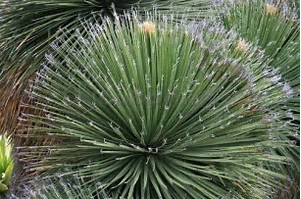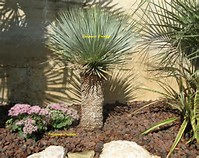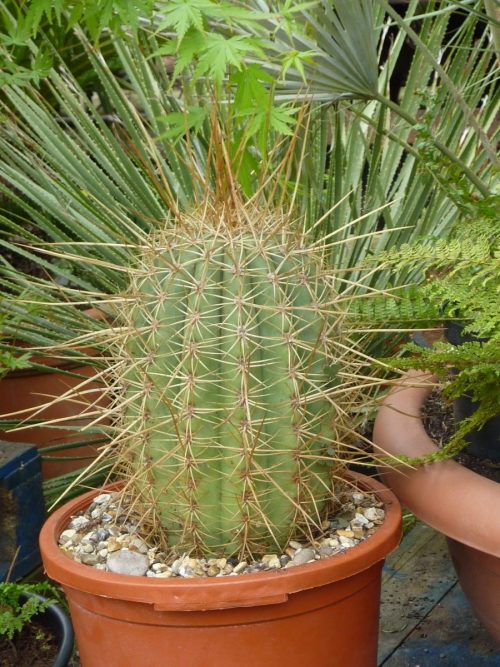-
 Dasylirion serratifolium is a species of Sotol from southern Mexico. However, in cultivation it is more of a 'catch-all' name for a mixed group of hybrids that have green leaves with toothed margins and terminal tufts. For all practical purposes this is unimportant to anyone other than a dasylirion specialist - in the garden they make a stunning focal point for the arid border along with Yucca, Nolina, Agave and Chamaerops with their fine-leafed 'fibre-optic lamp' appearance that contrasts well with other spiky plants. Alternatively their shape is perfect for pot culture, when they can be taken under glass for winter.
Dasylirion serratifolium is a species of Sotol from southern Mexico. However, in cultivation it is more of a 'catch-all' name for a mixed group of hybrids that have green leaves with toothed margins and terminal tufts. For all practical purposes this is unimportant to anyone other than a dasylirion specialist - in the garden they make a stunning focal point for the arid border along with Yucca, Nolina, Agave and Chamaerops with their fine-leafed 'fibre-optic lamp' appearance that contrasts well with other spiky plants. Alternatively their shape is perfect for pot culture, when they can be taken under glass for winter. -
 Yucca linearifolia ‘blue form’, also called Y.linearis. It has flexible, short green leaves up to 30-50 cm long, forming a perfectly spherical head. If through circumstances the base of the trunk is rotten, it can be cut off and the plant will make new roots via de outer trunk layer. Another remarkable quality is that if the crown is rotten you can treat it for mould and this plant will make new crowns. This plant can withstand temperatures down to -15 degrees Celsius.
Yucca linearifolia ‘blue form’, also called Y.linearis. It has flexible, short green leaves up to 30-50 cm long, forming a perfectly spherical head. If through circumstances the base of the trunk is rotten, it can be cut off and the plant will make new roots via de outer trunk layer. Another remarkable quality is that if the crown is rotten you can treat it for mould and this plant will make new crowns. This plant can withstand temperatures down to -15 degrees Celsius. -

 A native to the Chihuahuan Desert, inhabits western Texas and northern Mexico in the states of Chihuahua and Coahuila. Yucca rostrata, or Beaked Yucca, is typically found growing on rocky bajadas, slopes, or ridges that are comprised of limestone gravel. Beaked Yucca is a single-trunked arborescent yucca that reaches heights of 6-15 feet. Mature plants may branch and become multi-headed
A native to the Chihuahuan Desert, inhabits western Texas and northern Mexico in the states of Chihuahua and Coahuila. Yucca rostrata, or Beaked Yucca, is typically found growing on rocky bajadas, slopes, or ridges that are comprised of limestone gravel. Beaked Yucca is a single-trunked arborescent yucca that reaches heights of 6-15 feet. Mature plants may branch and become multi-headed

